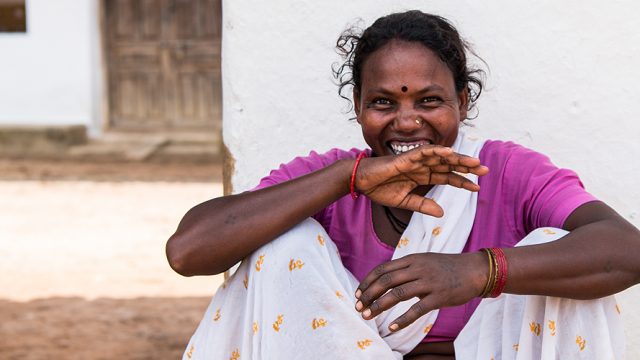We leave the dusty cityscape of Jabalpur behind to arrive at Bandhavgarh on a Wednesday afternoon, when the park is closed to tourists. Near the park’s Dhamokar Gate, the jungle gives way to rice and corn fields, and gradually, a settlement of blue and brown mud homes. I decide to explore the lush village on the periphery of the forest.

Pressed into the buffer zone of the park, Mardhari village is home to the Gond and Baiga tribal communities. Rice fields are bordered with thick lantana hedges to keep out wild visitors. Homes have sloping red roofs of baked-earthen tiles. Neem and mango trees border little kitchen gardens, where various pulses and vegetables like brinjal and gourd grow. Each family grows enough to sustain themselves. It’s just before the harvest, and the fields are punctuated with elevated bamboo-thatch machans. Until the harvest is done, villagers sleep in these open machans every night, to protect their fields from wandering animals.

The lives of Central India’s native Gond and Baiga tribes have been intertwined with the forest for generations. Sharing space and resources of the forest with the big cat and other species, the communities’ skills traditionally lie in an intimate knowledge of plants and animals. When these forests were declared protected areas, many villages were relocated out of the national parks, and access to the forest’s resources was restricted. Apart from farming, many locals now work as park guides or at lodges around the national park.

Walking between the fields and the forest, I spot a little jungle owlet on a branch and see a ruddy mongoose crossing my path. At 5 p.m, the village puts on a show when the cattle return home after grazing all day. Cows solemnly walk in single file down the narrow village path, each dispersing into their own home with no human guidance.

The next morning, I drive half an hour away to the Bijaria village near Bandhavgarh’s Tala Gate, set amidst lush fields of rice and corn. Woven bamboo fences surround kitchen gardens. Friendly locals invite me into their courtyard, where I see little brown kernels drying in the sun. “Mahua,” says the lady of the house, and invites me to have a taste. The dried flowers taste like raisins.

Widespread across Central India, the mahua tree is a gift that keeps giving. Locals extract oil from its seeds, the leaves are used as plates, and its fruits are cooked and consumed. When the flowers bloom in February, they are fermented to make a local liquor. In this case, the lady binds the dried and roasted blooms with jaggery to make energy-packed mahua laddoos, which farmers carry into the fields for nourishment during the long work day.
During tourist season, lodges in the area host Baiga dance performances, where 20 or so men and women play traditional instruments, sing, and perform folk dances. I’m keen to meet the members of the troupe who live in this village, but most of them are away working in the fields.

Though I don’t get a chance to meet the musicians in Bijaria, I catch a Baiga dance performance the next day at Kipling Camp in Kanha National Park—the next stop on my driving circuit.
At a clearing within the forest, under a low-hanging full moon, a large troupe of Baiga dancers from the nearby Nachantola village, puts up a vibrant performance. Catchy songs about the monsoon and upcoming harvest get my feet tapping. The performers are dressed in elaborate costumes and headgear, with woven grass braids and peacock feather shafts in their hair, and heavy metallic anklets on their feet. The men play drums called mandar, slung around their necks, while the women play the thiski—a wooden instrument with knobs that produces a clapping sound.

I’m impressed by their costumes, jewellery, and wide array of instruments. The performers function as a cooperative that Belinda Wright, conservationist and owner of Kipling Camp, helped establish. Belinda tells me that the group’s knowledge of their traditional song and dance had begun to fade away with the older generations. She identified another Baiga village where these age-old traditions were still alive, initiating a transfer of knowledge and skill between the two communities. During tourist season, the group performs at lodges to supplement their income.
The next day, I visit the Baiga village of Lagma at the other end of the national park near the Mukki Gate. Mahua trees and rice and jowar fields surround the small cluster of around 18 family homes. I visit the home of village head Vikram Baiga and his wife Juniya Bai. She shows me the inked geometrical patterns on her arms and legs, and then points to her forehead. Baiga women wear tattoos across their bodies, including on their faces. The tattoos function as an identifier of the tribe they belong to, and Juniya Bai believes it also brings them luck. She offers me a taste of the sharp, clear, drink they make from the mahua flower, stored in barrels.

Between game drives at both national parks, these visits to Gond and Baiga villages taught me about the cultures and traditions that stem from the forest. Through the music, dance, food, and stories of the communities that coexist with the jungle, I came away with a deeper understanding of India’s wild heart.
THE INFORMATION
Getting there: Jabalpur airport is 160 km/4 hrs from Bandhavgarh and 170 km/5 hrs from Kanha. Bandhavgarh to Kanha is 216 km/5 hrs. Ask your lodge to arrange a visit to nearby Gond or Baiga villages.
Stay
Bandhavgarh Jungle Lodge
Address: Tala Gate, Bandhavgarh National Park
Website: www.bandhavgarhjunglelodge.com
Tel: 011 26516770
Tariff: Doubles ₹8,500 per night, includes all meals and taxes.
Kipling Camp
Address: Morcha Village, P.O. Kisli – Kanha National Park, District Mandla, Madhya Pradesh 481768
Open: Oct 16 – May 15.
Website: www.kiplingcamp.com
Tel: +91 76492 77218
Tariff: Doubles from ₹16,600 includes meals, village visits, nature walks; plus taxes.
Gond tribe
Baiga tribe
MPonmymind
